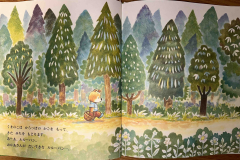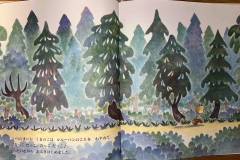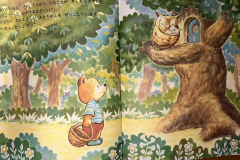These days I find myself wondering how pictures in a picture book are made. People draw them, yes. But how do they create such a cohesive story with their pictures?
The most conventional way of creating pictures is drawing them by hand. Nonetheless, Pictures in picture books are created with various tools:
- hand drawing
- digital art
- photographs etc.
In addition, there are picture books that incorporate traditional Japanese crafts like origami paper folding and kirie paper cutting. Kirie is an ancient Japanese technique that dates back to the 7th century and was originally used for religious ornaments. Over time, the technique has evolved to include washi (Japanese paper) decorations and is now sometimes used in the illustrations of picture books.
The art of Kirie creates contrast between solid colour lines, which are literally cut from paper, and various background options. In kirie, the background is a flexible entity, which can be coloured – sometimes randomly – with parts of the background, or the picture can be placed against a background with a pattern, or a solid background can be used. This technique allows for intricate and beautiful designs to be created with the simple use of paper and scissors.
The art of kirie is often used to create magnificent pieces of artwork with scissors and cutters. Through my personal experience with kirie, I have come to understand the vast possibilities that exist within a picture.
What I learned from creating kirie
Recently, I created a kirie design by using the work of Kyoko Yanagisawa, an artist based in Nagano, Japan. Yanagisawa is the author of several books on kirie, and my favorite among them features traditional Japanese lifestyle depicted in kirie pictures.
My personal experience has a simplified version of kirie. I did not create the design, I just used the template that Kyoko Yanagisawa created. Here’s a short record of the process.
To be honest, the process I used to create my kirie was not the traditional method. The traditional method involves using a sharp knife to carefully and precisely cut each line. It’s similar to drawing, but with a paper knife. Unfortunately, the scissors I had were not sharp enough to cut out the smaller objects, so I had to improvise and adapt the process.
When I was a child, I used to fold paper and cut out small pieces to create patterns, such as snowflakes. This childhood technique was similar to kirie in some ways. However, kirie is traditionally created by carefully cutting every line with a knife, like drawing a picture, but with a paper-knife. Although my scissors were not sharp enough to cut out small objects in the kirie template, I improvised and used the folding and cutting technique that I enjoyed as a child. While a kirie expert might criticize me for being too innovative, I did my best and I am pleased with the result.
Kirie technique in a picture book
In his book Hugs (だっこだっこ Dakko Dakko) by Tsuchida Yosiharu, the illustrator used kirie-inspired techniques to create contrast between the characters and the background. Instead of using a solid color background, the illustrator used patterned paper to create a textured background. The characters were then cut out and placed on top of the background, creating a layered effect.
This technique creates a sense of depth and adds an extra dimension to the illustrations. It also allows for the characters to stand out and be more easily distinguishable from the background. The use of kirie-inspired techniques in this picture book demonstrates how traditional techniques can be adapted and used in new and creative ways.
Noticed a similar pattern?


